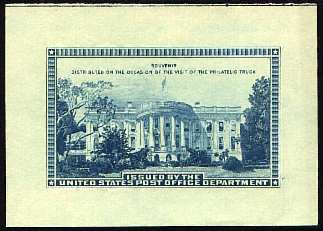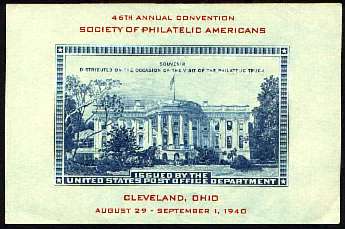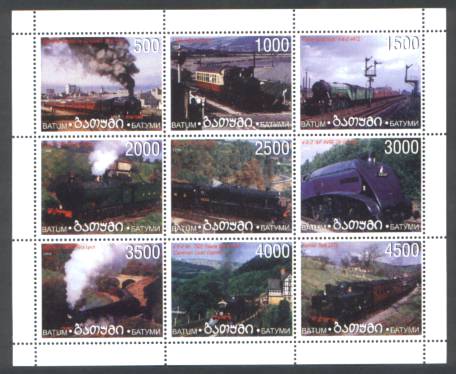

C is for Cinderella Stamp - Page 3 |

|

|

|

|
Eaton's Ad

The Eaton Paper Company issued the set of Cinderellas above as a self-
promotion in 1939.
The stamps were given away in boxes of Eaton's stationery, at the NY
World's fair of that year.
They are among my favorites, for several
reasons - the beauty of their designs, the use of engraving, and the train
on the top middle one above.

The Eaton's stamps were so good that this one fooled the U. S. Post Office,
and the fact that it
carries the train stamp makes this cover a prized item in my collection.
Roger Riga, of Rigastamps ( my favorite Cinderella Stamp dealer) has showed me
a couple of other
covers with stamps from this series, all posted in the late fourties and early
fifties. His theory,
which I like, as to why the covers showed up then, is as follows: People who
acquired them in 1939
knew what they were, and did not try to use them as postage. But ten or
fifteen years later, as
someone was rifling a drawer for something, that box turned up again, and the
finder didn't know
what it was. The stamps looked enough like the real commemoratives of the period to seem like real postage,
and were used in an
honest error.

Here's another example of these Eaton's advertising stamps used to "pay"
postage, this one
postmarked New York, and addressed to England! It's dated 1967, so again it's
not contemporary with
the actual creation of the stamps, which probably helps explain why it slipped
by. Still, it must
have been processed by hand - what could the clerk have been thinking? The
stamps don't even have
denominations!
The date of mailing looks like MR 8, 1967, which I assume means March 8, 1967 (there's one more handstamp on the other side, with a clear "1967").
From July 1, 1961 through April 30, 1967, the surface rate from the US to England was 11¢ for the first ounce, and 7¢ for each additional ounce. So, a two-ounce letter would have cost 18¢, and three-ounces would have been 25¢. Neither fits.
Too bad the postmark isn't two months later, since starting May 1, 1967, the rate was 13¢ for the first ounce, and 8¢ for each additional, so a two-ounce letter would have cost 21¢, which would fit perfectly, assuming the clerk thought these were all 3-cent stamps: three times seven = twenty-one!
But seven times nothing is still nothing. Another prized item.
The source of the postal rates quoted above is U.S. International Postal Rates, 1872-1996, by Anthony S. Wawrukiewicz and Henry W. Beecher
The Philatelic Truck
The Philatelic Truck was an engaging eccentricity of the USPOD right
before WW II. As
with most stamp-related activities during his tenure in office, FDR
probably had a hand
in its creation. The truck was a custom-built, heavily armored
vehicle with an exhibit
of all U.S. postage stamps issued to that date on display in specially-
mounted stands
inside. It toured the country for 2-1/2 years, from May 9, 1939 to
December 13, 1941,
stopping at schools, libraries, etc. Visitors were given one of
these special souvenir
sheets, printed by the BEP, and now considered forerunners of the
Bureau Souvenir Cards
created since (Size of these souvenir sheets is about 4-1/4 wide).
James Bruns, who is the former
Director of the National Postal Museum in Washington, DC,
published a wonderful
book about the Philatelic Truck.
See my
References page.
This is one of the scarcer varieties of the Philatelic Truck souvenir sheet, overprinted at a convention of the SPA in 1940 while the truck was visiting there.
Fakes, Forgeries, and Phantoms
Fakes, forgeries, and phantoms are also classed as Cinderellas, which brings up the important fact that some people will try to pass off as valid postage stamps items that are nothing more than labels. The sheetlet above, while attractive, and appealing to a collector of trains on stamps such as myself, purports to be postage for the country Batum, which does not exist.
If labels are what you choose to collect, then no problem, but if you want to avoid cluttering your stamp collection with fantasies, you might want to check out the Arthur Salm Foundation and the The Collectors Club of Chicago, their Report Number 4: Labels Purporting to be Stamps. At their main page, click on REPORTS to drop down the list, then select Number 4.
THIS JUST IN - 3/12/2002 - a viewer writes:
You say there isn't such a country as Batum - rightly; but if you look up the site you point people to you'll see there is such a town and it did have stamps issued (by British occupiers) in 1919-20. The English and Russian on your very nice set occurs on those too, but not the native language. I think this historical stuff is interesting and obviously what inspired the stamps. Incidentally it was a Russian oil town occupied by the Turks in March, 1919, and then taken by British anti-Bolshevik interventionists later that summer. A very early example of 'world policing' (as the Bushes put it) that only seems to happen where oil is at stake!
After a few exchanges of email, that viewer contributed a page of the philatelic history of Batum, HERE.
Yann also provided
this link to a photo of Batum in 1911, about which he says:
The photo is, I think, from an Austrian travel book. The caption says more or less: The chief town of the district of the same name [well that soon changed!], and the most important harbor on the east pontine [Black Sea] coast, lies at the foot of the westermost foothills of the Armenian highlands. Our view is over the town (population upwards of 30,000) from the railway station on the Baku line. The chief produces are petroleum products, manganese, licqourice and wool.
And he suggests:
If you type Batum/postcard onto your search engine you'll find a site with some magnificent old views over the harbour to the snowclad mountains. I also found a modern traveller's description saying they still have trams and that the train runs thru the streets.
Many thanks to Yann Lovelock for all that interesting and entertaining information about Batum.
| Home | C - page 2<<< | Contents | >>> D is for Duck stamps | Credits |
All Letter images Copyright © 1997, 2000, SF chapter of AIGA
All text Copyright © 2000, William M. Senkus
Send feedback to the webmaster: CLICK HERE
Revised -- 11/13/2017




